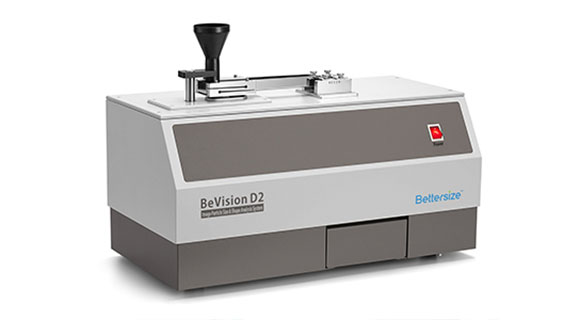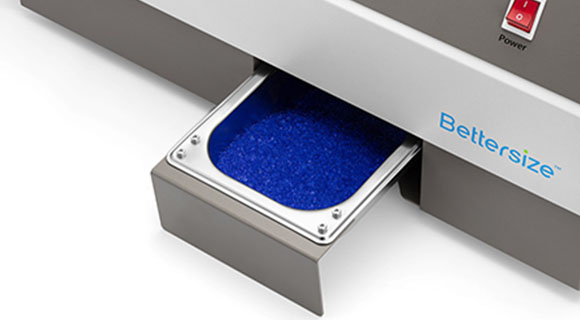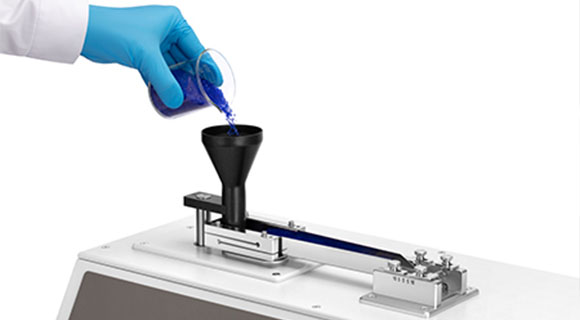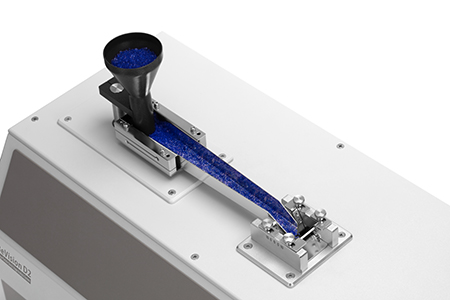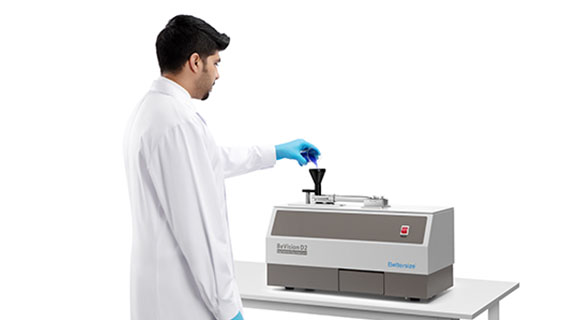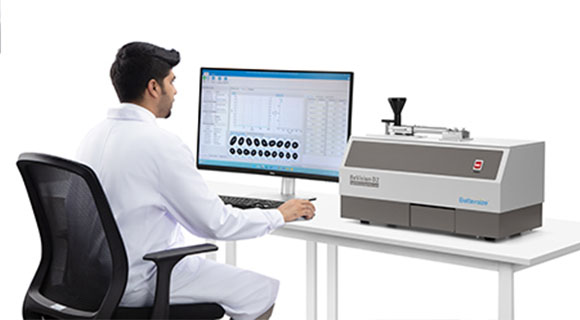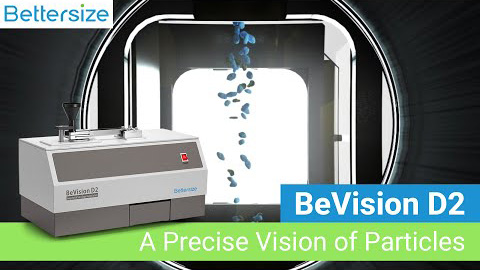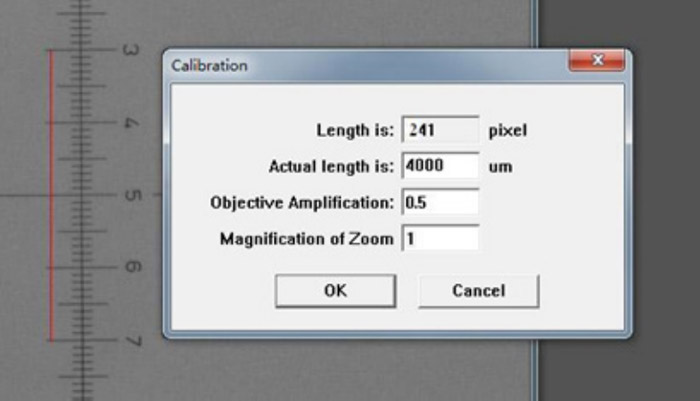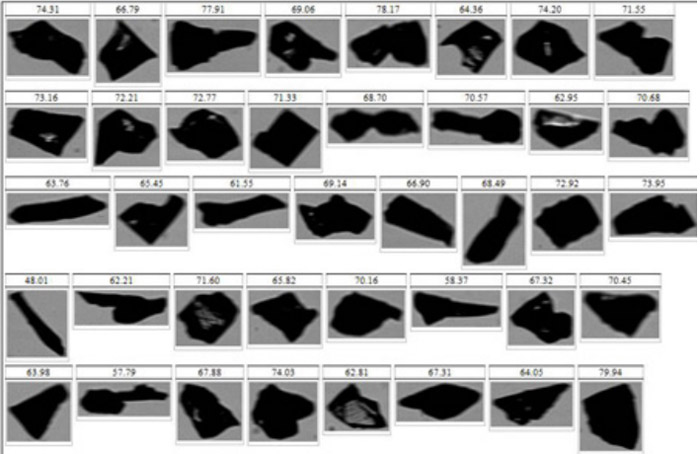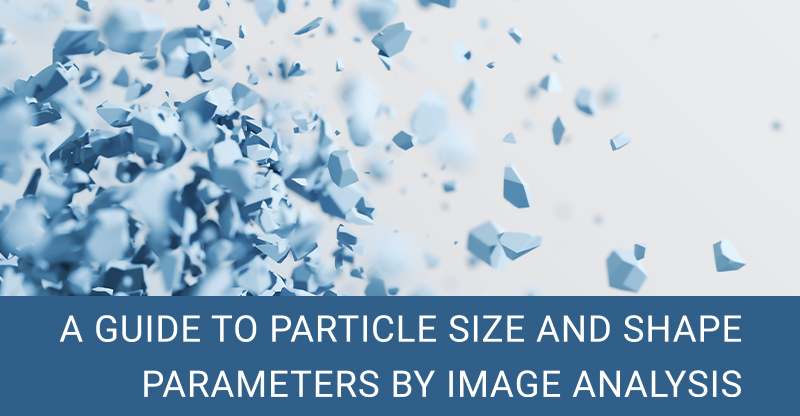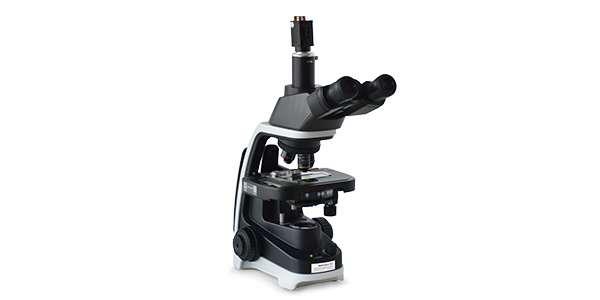BeVision D2
O BeVision D2 oferece uma solução eficiente para a análise de tamanho e forma de pós ou grânulos secos e de alta fluidez. Dezenas de milhares de partículas podem ser medidas por um BeVision D2 em três minutos. Combinando uma câmera de alta velocidade com uma lente telecêntrica precisa, o BeVision D2 é capaz de analisar com eficiência o tamanho e a forma das partículas na faixa de 30 a 10.000 μm.
Recursos e benefícios
- ● Faixa de medição: 30 - 10.000 µm
- ● 24 parâmetros diferentes de tamanho e forma de partícula
- ● Alto rendimento da amostra: Medição de 10.000 partículas em 3 minutos
- ● Excelente reprodutibilidade
- ● Resultados em conformidade com a norma ISO 9276-6
- ● Operação totalmente automatizada
- ● O software avançado oferece uma avaliação abrangente
- ● Comparável aos resultados de peneiramento
Vídeo
How to Install and Operate BeVision D2 
BeVision D2 | A Precise Vision of Particles 
What is Image Analysis? Fundamentals of BeVision Series 
Overview of BeVision Series | Precision in Particle Vision 
Visão geral
1) Por que o método de análise de imagens?
- Fácil
Capture uma imagem de partículas, identifique as partículas e, em seguida, meça seu tamanho e forma. Cada etapa da análise de imagem é fácil e clara.
- Análise da forma
Com base em uma visão direta das partículas, é possível analisar não apenas o tamanho das partículas, mas também sua forma.
- Ver para crer
O método de análise de imagem determina o tamanho e a forma de cada partícula individual e, em seguida, soma tudo para formar uma estatística. Os detalhes da distribuição do tamanho ou da forma das partículas podem ser fornecidos com precisão.
2) Por que o método de análise dinâmica de imagens?
- Eficiência
Um fluxo contínuo de partículas passando pela zona de medição ajuda a obter uma maior eficiência da medição.
- Sensibilidade a partículas de tamanho grande
O método de análise de imagem dinâmica é sensível a partículas de tamanho grande; é possível até mesmo estimar o tamanho de partículas de tamanho grande.
- Resultados confiáveis
O número máximo de partículas medidas garante a significância estatística dos resultados da medição.
3) Hardware BeVision D2: Precisão e eficiência garantidas para você
Para medir o tamanho e a forma das partículas em uma grande variedade de aplicações, o BeVision D2 foi equipado com uma ampla gama de hardware. De acordo com as propriedades do material da amostra, a seleção do melhor hardware pode ajudar a medir o tamanho e a forma das partículas com precisão e eficiência ideais.
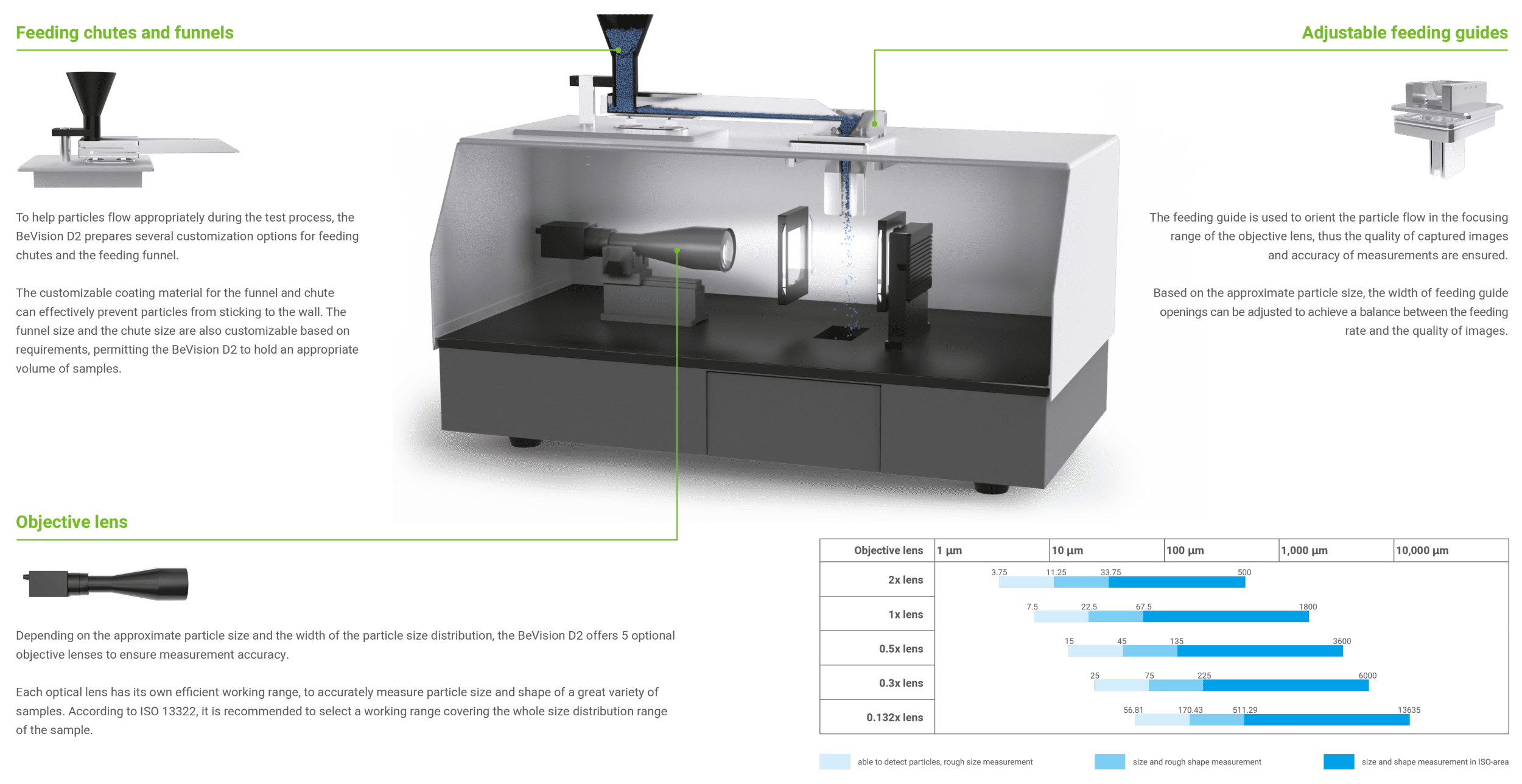
4) Parâmetros de tamanho e forma de partícula:
- Parâmetros de tamanho
Diâmetros equivalentes: diâmetro equivalente à área, diâmetro equivalente ao perímetro;
Diâmetros de Feret: diâmetros máximo e mínimo de Feret, XLF ('comprimento')
Diâmetros de Martin: diâmetros máximo e mínimo de Martin;
Elipse de Legendre: eixos maior e menor
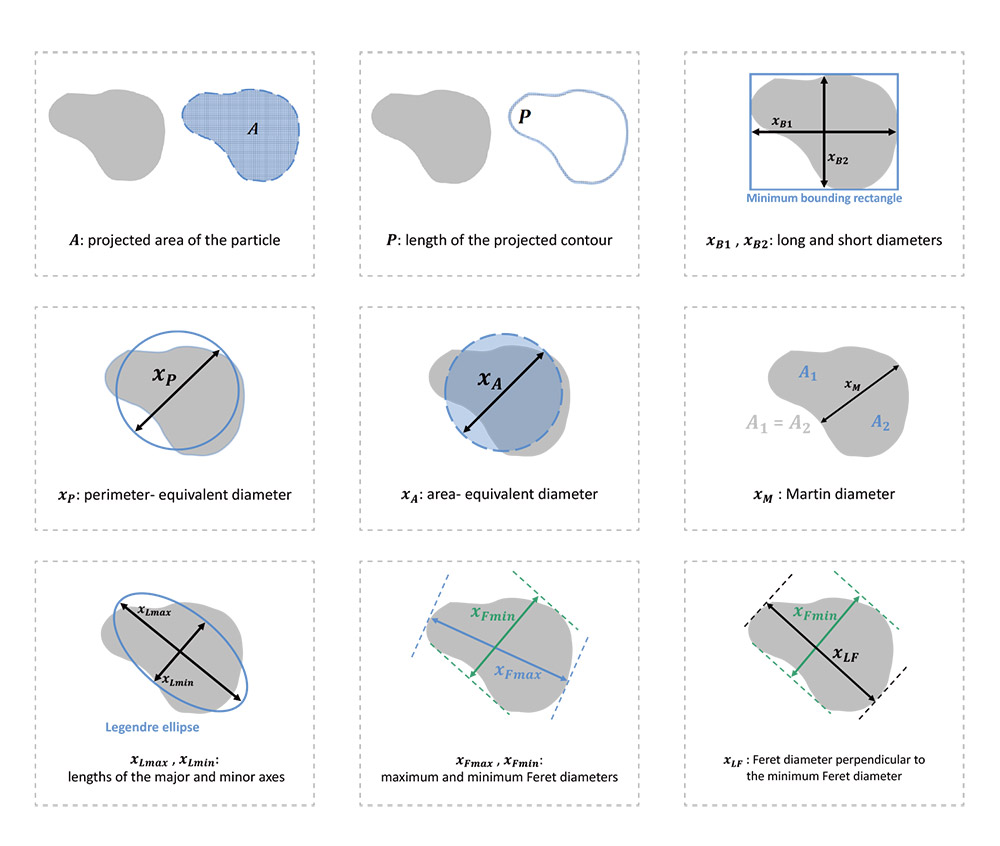
- Parâmetros de forma
Diferença de tamanho em 2 direções: razão de aspecto、razão L/W、razão de elipse;
Semelhança com o redondo e semelhança com o retângulo: Circularidade、irregularidade、compactação、extensão、relação de caixa
Concavidade do contorno: Concavidade、convexidade、solidez;
Para partículas alongadas: Alongamento、retidão

5) Software BeVision: Insights visualizados para você:
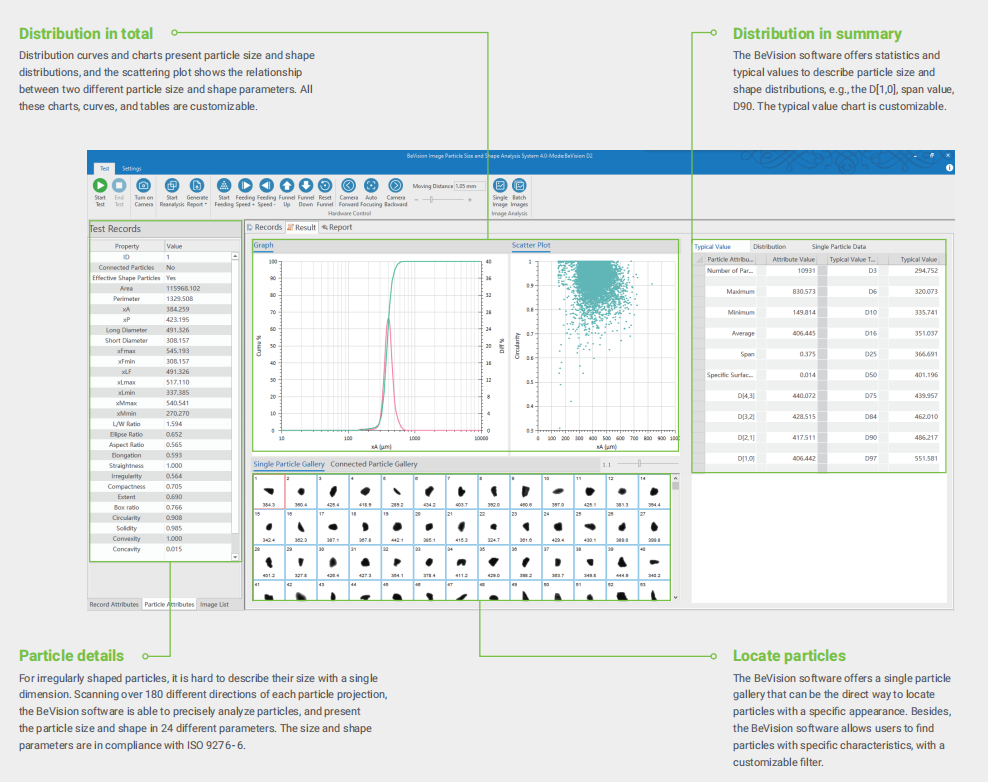
6) Aplicativos típicos:

Citations
- Bettersizer 2600
Functional redundancy as an indicator for evaluating functional diversity of macrobenthos under the mussel raft farm near Gouqi Island
DOI: 10.1016/j.aquaculture.2023.740024 Read ArticleZhejiang Ocean University | 2024Biological traits analysis (BTA) helps to evaluate the effects of different environmental variables on the traits-based functional composition of macrobenthos. However, research on functional traits of macrobenthos under mussel farming is limited. We investigated the spatial and temporal response of the benthic system in terms of taxonomic and functional diversity to environmental variables of farming and natural stressors resulting from suspended mussel farming near Gouqi Island of eastern China Sea. The functional traits of macrobenthic assemblages under mussel farming were characterized by “medium adult body size”, “vermiform body form”, “high flexibility”, “infauna”, “semi-motile”, “gonochoristic”, “surface deposit-feeders”, “carnivores”, “semi-motile burrowers”, and “tube-dwellers”. Functional redundancy was stable in response to mussel farming stresses among seasons, whereas species diversity showed efficient to evaluate natural variables. Functional diversity was significantly affected by farming stressors rather than natural variables, Further analysis using multivariate methods together with continuous monitoring were highlighted to evaluate the impacts of mussel farming. Our results reinforce the importance of macrobenthic species and functional traits analysis to evaluate human stresses driven impacts in offshore ecosystems. By analysing the environmental variables with different sources, independently, we concluded the main effects of human pressures on macrobenthic community. Such distinction could be particularly effective to isolate variable environmental descriptors and evaluate their effects on functional diversity, making the current approach promising for the evaluation of ecological effects of anthropogenic stressors in aquaculture areas. - Bettersizer 2600
Degradation characteristics and utilization strategies of a covalent bonded resin-based solid amine during capturing CO2 from flue gas
DOI: 10.1016/j.seppur.2023.125621 Read ArticleChina University of Petroleum | 2024In this study, various types of degradation as well as attrition which are possibly encountered in a circulating fluidized bed temperature swing adsorption (CFB-TSA) process, were conducted experimentally to evaluate the stability of a resin-based solid amine sorbent. Other characterizations methods, such as elemental analysis (EA), Fourier transform infrared spectroscopy (FTIR) etc. were applied to further reveal the degradation mechanisms. The results showed that thermal degradation occurs from 140–160 °C due to the decomposition of amine group. The CO2-induced degradation occurs from a higher temperature of 160–180 °C accompanied by the production of urea. Hydrothermal stability is good below 130 °C, but the ionic impurities in steam crystalized on particle surface can accelerate the degradation. Oxidative degradation is the most harmful, which starts at a lower temperature of 70–80 °C with the formation of aldehyde. The existence of H2O in atmosphere can alleviate the oxidative and CO2-induced degradations. The employed sorbent has a very low attrition index of 0.05, which is 1–2 orders lower than typical commercial fluidized bed catalysts. Based on the results of stability evaluation, some design suggestions for proper utilization of this sorbent or other similar resin-based sorbents have been provided in an industrial CFB-TSA process.
- Bettersizer 2600
De-branching of starch molecules enhanced the complexation with chitosan and its potential utilization for delivering hydrophobic compounds
DOI: 10.1016/j.foodhyd.2023.109498 Read ArticleShihezi University | 2024The current study aimed to prepare the complexes between debranched-waxy corn starch and chitosan polymers (DBS-CS), and then investigated their corresponding structural characteristics, rheological property and potent application in Pickering emulsion. The results indicated that the existence of chitosan significantly inhibited starch short-range molecular rearrangement for all DBS-CS samples, which was manipulated by both debranching treatment and chitosan content. Interestingly, this is the first study to reveal that the outstanding peak at 1.8 ppm in 1H NMR spectrum for sample DBS-CS was gradually shifted towards a lower-field region following an increased chitosan content. Moreover, the debranching treatment shifted the crystallinity pattern from A-type to B-type and the relative crystallinity of DBS-CS decreased gradually with the increased content of CS. All samples had a pseudoplastic fluid and shear-thinning behavior with an enhanced shear resistance following the complexation. The DBS-CS was applied in a Pickering emulsion for showing a greater emulsifying stability and a lower gel strength than native NS-CS prepared emulsion. Importantly, the encapsulation ability of curcumin in the DBS-CS emulsion was significantly improved, followed by an increase of 15.45% for its corresponding bioavailability compared to the control. Therefore, this study might highlight a potential carrier for delivering the bioactive substances in a green pattern. - Bettersizer 2600
Heat-induced aggregation behavior of wheat gluten after adding citrus pectin with different esterification degree
DOI: 10.1016/j.foodhyd.2023.109420 Read ArticleGansu Agricultural University | 2024Wheat gluten aggregation during heat treatment is beneficial to the final quality of gluten-based products. Exogenous pectin can affect gluten aggregation. However, the effect of pectin with different degrees of esterification on the heat-induced aggregation behavior of gluten and its possible mechanism are still unclear. Thus, the heat-induced aggregation behavior of gluten after adding pectin with different esterification degree was studied in this study. When the temperature was raised from 25 °C to 95 °C, pectin affected gluten aggregation and was related to the degree of esterification. Specifically, the results of rheological properties and particle size indicated that low-ester pectin improved the viscoelasticity of gluten and promoted gluten aggregation. Thermal properties revealed that enthalpy of gluten added with low-ester pectin (37%) increased from 92.96 J/g to 95.40 J/g during heating process. Structurally, the fluorescence intensity and surface hydrophobicity of gluten added with low-ester pectin (37%) were lower than those added with high-ester pectin (73%). In addition, low-ester pectin (37%) significantly increased the disulfide bond content (from 15.31 μmol/g to 18.06 μmol/g) and maintained β-sheet content of gluten compared with gluten alone at 95 °C, indicating that low-ester pectin was more likely to induce gluten aggregation. However, scanning electron microscope showed that the gluten added with low-ester pectin (46%) exhibited a denser network structure at 95 °C than that added with low-ester pectin (37%). These results will provide a theoretical base for the regulation of gluten aggregation and the quality of gluten-based products by pectin with different esterification degree.
- 1
- 2
- 3
- 4
- 5
- 6
- 84
Recursos selecionados
Analisador de imagens relacionado
-
Bettersizer S3 Plus
Particle Size and Shape Analyzer
Measurement range: 0.01 - 3,500μm (Laser System)
Measurement range: 2 - 3,500μm (Image System)
-
BeVision M1
Automated Static Image Analyzer
Dispersion type: Dry
Measurement range: 1 - 10,000μm
Technology: Automated Static Image Analysis
-
BeVision S1
Classical and Versatile Static Image Analyzer
Dispersion type: Dry & Wet
Measurement range: 1 - 3,000μm
Technology: Static Image Analysis


